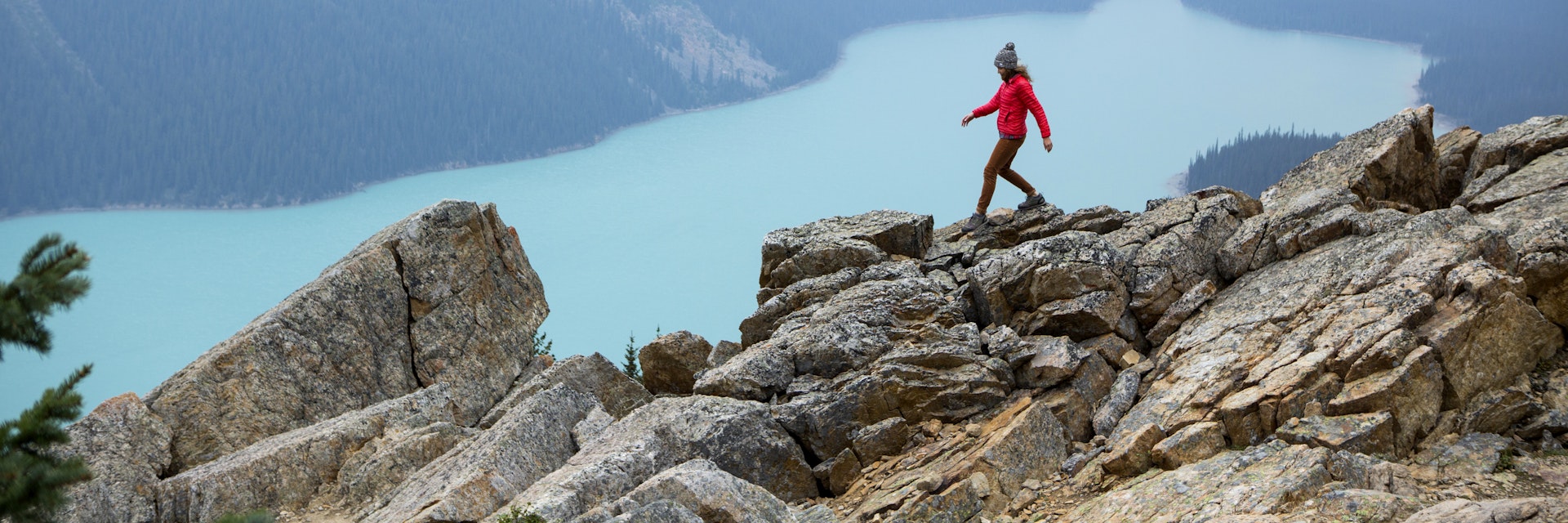Why you should go
Of all Canada’s top sights, Banff National Park justifiably ranks as many people’s number one. As much a piece of history as a natural wonder, Canada’s oldest national park, founded in 1885, is what Canada is all about. It’s a feral, but largely accessible, wilderness that attempts to cater for everyone – and largely succeeds – from bus-tour visitors to hard-core mountaineers.
The towering mountains of Banff provide endless opportunities for wildlife-watching, hiking, boating, climbing, mountain biking, or skiing. But you don’t have to be a seasoned outdoor-enthusiast to enjoy Banff–its natural beauty will astound even those who just want to soak up the sights. Rugged canyons compete for your attention with fields of alpine wildflowers, turquoise lakes–like the famed Lake Louise and Moraine Lake–and dense emerald forests.
One of the great beauties of Banff is its juxtaposition of the untamed and the civilized. Grizzly bears roam within growling distance of diners drinking cocktails at the romantic Banff Springs Hotel, while hikers fresh from summit attempts queue up for ice cream with golfers clutching nine irons.
History
Banff is a piece of history in itself. The region was home to First Nations peoples for 10,000 years before the creation of the park in 1885. Banff National Park is the world's third-oldest national park (and Canada's oldest). Cataloguing past triumphs and tribulations, Banff Town supports a healthy cache of four museums, virtually unparalleled for a 'natural' national park.
Tickets and other practicalities
Park admission is C$10 for adults, C$8.70 for seniors, C$20 for families and free for kids under 17. There are additional fees for campground use, backcountry camping, fire permits and fishing permits. See the latest fees on the Banff National Park website.
Camping in Banff National Park
Banff has 14 frontcountry campgrounds catering for tents, recreational vehicles (RVs) and camper vans. Most are open from around June to mid-September, although Tunnel Mountain Village Two and Lake Louise Trailer campgrounds are open year-round.
Advance reservations are available for Tunnel Mountain, Two Jack, Johnston Canyon, Lake Louise and some sites at Rampart Creek. The Parks Canada website starts taking reservations in January each year for a fee of C$11 in addition to regular camping fees. Book as far ahead as possible, as sites fill up fast.
Sites at all other campgrounds are allocated on a first-come, first-served basis, so the best way to claim a spot is to turn up early (around the official 11am checkout time is best) or check with parks staff about which campgrounds currently have availability. Banff Park Radio (101.1FM) also releases regular bulletins on campgrounds with available sites. It’s a good idea to stay in one place over weekends; sites are generally easier to come by midweek.
There’s a maximum stay of 14 nights and a maximum occupancy of six people per site. At larger campgrounds you can pay fees at the entry kiosk, but at smaller campgrounds, you’ll have to self-register: find a vacant site first, then go to the self-registration shelter, remembering to enter your name, site number, license plate and duration of stay on the envelope along with the relevant fees. If it’s late when you arrive, you can do this in the morning, or sometimes staff will come around and collect your fees in person in the morning.
Fires are usually allowed at campsites where there’s a fire pit – you’ll need to buy a fire permit (C$8.80, including wood) from the campground entrance. Watch for fire restrictions during dry periods.
Hotels in Banff National Park
Despite having enough hotel rooms to rival a town three times its size, finding a place to sleep in Banff Town can be tricky. Demand is huge, and rates are notoriously expensive, especially in peak season. Many visitors choose to cut costs by camping, hosteling, hiring recreation vehicles or staying in nearby Canmore. Regardless of where you stay, book well ahead, especially if you're coming in June, July or August.








